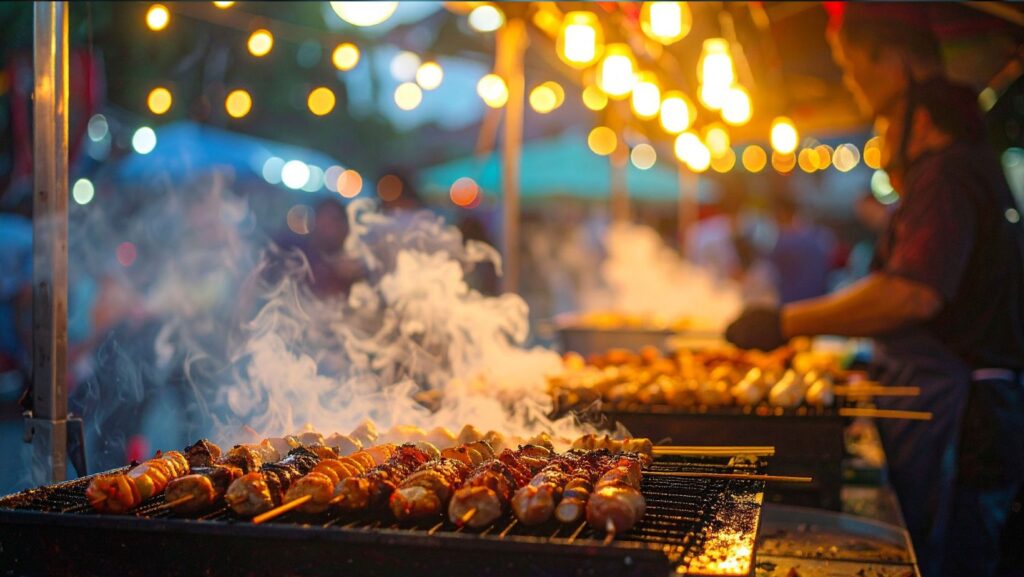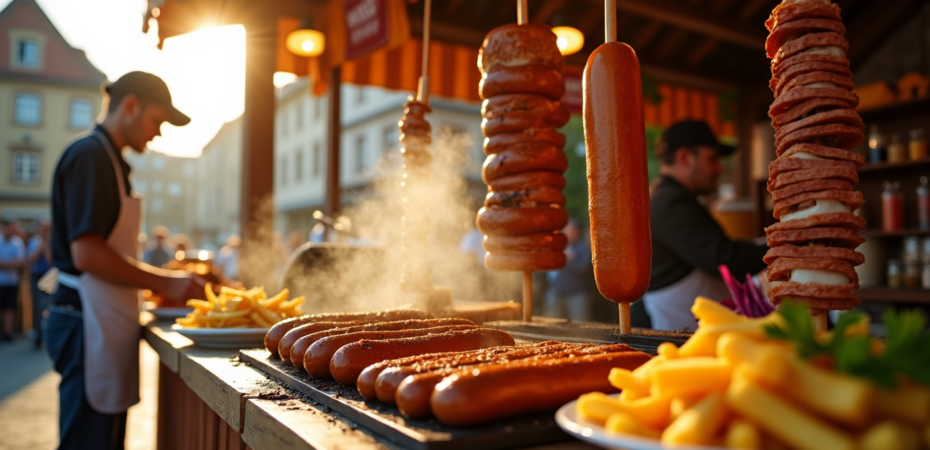Germans devour an incredible 800 million servings of currywurst every year. This remarkable statistic barely hints at the amazing German foods waiting for you to find. The ountry’s rich culinary scene features everything from 40-plus varieties of bratwurst to the popular döner kebab that arrived in the 1960s.
German cuisine extends well beyond these street favorites. Popular foods showcase centuries of cultural development, from the EU-recognized Maultaschen to Labskaus—a cherished sailor’s comfort dish. Your culinary adventure through Germany’s most beloved dishes awaits, and we’ll guide you through popular eateries and wallet-friendly spots where locals love to eat. If you’re planning a trip and want to explore the best that Germany has to offer, check out this guide for expert travel tips and insights.
Must-Try Traditional German Street Snacks
German street food tells a delicious story of regional pride and culinary breakthroughs across the cobblestone streets of Berlin and the bustling markets of Munich. Bratwurst, the lifeblood of traditional food in Germany, has more than 40 unique varieties. Germans serve this beloved sausage in crusty white bread rolls with mustard sauce, and each region takes pride in its distinctive version.
Kartoffelpuffer, crispy potato pancakes that showcase Germany’s love for potatoes, are among the most popular foods in Germany. People traditionally enjoy these golden-brown delights with applesauce or sour cream. The northern Germans have their own take on street food— Fischbrötchen, a simple yet satisfying fish sandwich that features marinated herring, fried fish, or smoked salmon.
German dishes have grown richer with contributions from immigrant communities. Döner Kebab is a perfect example that went through an interesting change when Turkish immigrant Kadir Nurman adapted it to German tastes by serving it as a sandwich. The addition of salad and garlic sauce created what we now know as an essential part of Germany’s street food scene.
Pretzels (Brezeln) are another lifeblood of German street snacking that you’ll find everywhere from grocery stores to gas stations. These twisted breads get their distinctive texture through a unique alkaline bath before baking. Germans love them with mustard or cheese, and they’ve become a symbol of German baking heritage.
Where Locals Eat in Major Cities
Food markets are the beating heart of Germany’s culinary world. Hamburg’s Fischmarkt, a local institution since the 18th century, draws thousands of hungry visitors every Sunday morning (5 AM to 9:30 AM) along the River Elbe. The city’s Food Lovers Market in HafenCity delights visitors with everything from Cajun cuisine to Korean bibimbap.
Munich’s Viktualienmarkt has been a 200-year-old farmers’ market with over 140 stalls that offer regional delicacies. The Münchner Suppenküche stands out with its rich, varied soups and local specialties. The city’s Heidi und Paul has become a local favorite, serving fresh salads and organic beef burgers.
Badias Kitchen in Frankfurt brings a colorful mix of oriental spices and seasonal ingredients from Hesse. The city’s Jaffa Market excels at classic Israeli cuisine and is known for its sumptuous falafel platter and Mediterranean moussaka. Bader’s Fisch Deli has earned cult status among locals with its exceptional fish sandwiches.

The best German dishes can be found at an Imbiss (food cart) or Schnellimbiss. These local spots serve food on biodegradable plates, showing Germany’s steadfast dedication to environmental consciousness. Local bakeries across these cities are a great way to get quick bites and traditional German treats.
Budget-Friendly German Food Guide
Smart shoppers can enjoy the best German foods without spending too much. Budget-friendly supermarkets like Aldi, Lidl, Netto, and Penny sell quality groceries at reasonable prices. A single person needs about €50-€100 weekly for groceries, while families spend between €150-€300 each week.
University neighborhoods have some great budget dining spots. Students and visitors alike can enjoy affordable meals at campus cafeterias and bistros. These places welcome everyone, which makes them perfect spots for travelers watching their budget.
German street food markets give you traditional food at great prices. A döner kebab sandwich costs €3-€5, and you’ll pay €2-€4 for a classic bratwurst in a roll. Weekly markets are budget-friendly options where vendors sometimes sell 4 kilos (8.8 pounds) of grapes or 20 apples for €1.
Here are some clever ways to save money on German dishes:
- Head to farmers’ markets just before closing time to get better deals.
- Check out “Voku” (public kitchens) where you can pay what you can afford.
- Use the “Pfand” system by returning bottles to get your deposit back.
Berlin’s Türkenmarkt along Maybachufer shows how affordable shopping can be. You’ll find fresh produce, spices, and traditional ingredients every Tuesday and Friday from 12 PM to 6:30 PM. The Thai Park in Schöneberg also offers budget-friendly street food from Friday through Sunday.
Conclusion
German food culture goes well beyond what tourists typically expect. While bratwurst and pretzels are beloved classics, local markets, and street vendors offer an exciting blend of old and new flavors.
You can get authentic food at great prices from places like Hamburg’s Fischmarkt and Munich’s Viktualienmarkt. Your food budget stretches further when you shop smartly at discount stores, university cafeterias, and markets near closing time.
Eating like a local means trying different foods. Each region puts its own spin on German classics. Northern Germany’s Fischbrötchen and Bavaria’s unique bratwurst varieties showcase these regional differences. German street food becomes an adventure when you experience it yourself.
Local food markets can be your gateway to real German cuisine. With some planning and local tips, you’ll find meals that fit your taste and budget. Good German food doesn’t need to be expensive—you just need to look beyond tourist spots and eat where locals eat.


 By
By 




